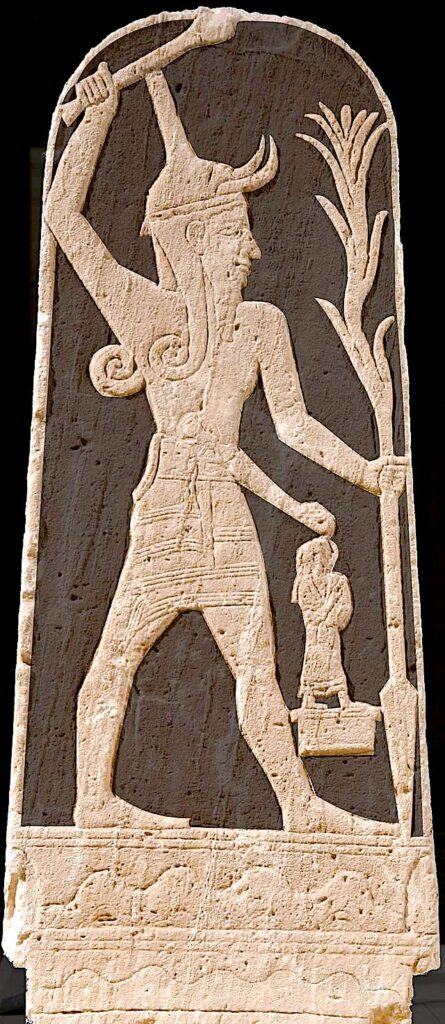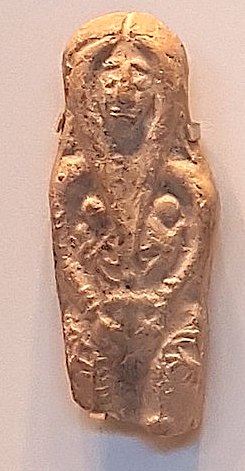What were the fertility cults of ancient canaan?
The fertility cults of ancient Canaan were a part of their religious culture, with rituals and practices centered around the worship of fertility gods and goddesses like Asherah and Baal. These cults sought to promote prosperity and abundance in the form of plentiful crops and herds, as well as children. Offerings, sacrifices and dances were part of the cults, and fertility rites and sacred prostitution were also associated with their worship. These
Other aspects of these cults included incantations, rituals, and supernatural beliefs aimed at manipulating the gods to bring desired results. A number of Canaanite gods were associated with fertility, including Baal, Anat, and Asherah.
The ancient Canaanite god – Baal

Baal was one of the most important gods of the Canaanite pantheon, and a major figure in ancient fertility cults. He was known as the ‘Lord of Heaven and Earth’, and was believed to bring abundance to the land through his powers of fertility. Archeological discoveries show Baal represented as a bull or a man with horns, and associated with thunder and lightning, agriculture, and stormy weather.
He was also often depicted as a warrior who fought against chaos and disorder. In ancient Canaan, the worship of Baal was very prominent, with various festivals and rituals celebrating his power. He was typically offered food, drink, and other gifts as part of large sacrifices in his honor.
By the time of the Romans and early Christianity, the worship of Baal had largely declined. However, many aspects of Baal’s cult beliefs and practices remain in modern culture, particularly in various forms of folk religion. The power of fertility and abundance symbolized by Baal continues to be found in pagan rituals around the world.
When were the ancient festivals of Baal?
The ancient festivals of Baal (Feast of Baal) typically took place in the spring, as this was seen as a time of renewal and fertility. Specific festivals would vary based on local practices, but common activities included large public sacrifices, offerings, processions, and other celebratory rituals. These festivals were seen as ways to honor and show reverence to Baal in order to receive his blessing of abundance and fertility. There was often singing and music, as well as feasting and drinking.
What type of offerings were given during the Feast of Baal?
During the Feast of Baal, common offerings included food and drink, animals, materials, and other valuable items. Oxen, sheep, goats, and birds were all commonly sacrificed, and the meat was usually consumed as part of a celebratory, communal feast. People would also offer gifts of precious metals, jewelry, and money.
How was Baal depicted?
Baal was normally depicted as a strong and powerful bull when displayed in his animal form, but he was also often represented as a horned man. Around his waist was a belt and his head adorned with a crown.
Over his forehead was usually a circular lightning bolt symbolizing his connection to thunder and lightning. He was also associated with rain and storms, which was sometimes represented by a bull-like figure holding a thunderbolt.
The image of Baal holding a lightning bolt, shows his power and strength. He was believed to be the lord of heaven and earth, so the lightning bolt was meant to represent his dominion over the sky, thunder, and lightning. It also symbolized his role as protector and patron of fertility and abundance, as he could bring wealth and blessings to the land through the stormy weather.
Who was the ancient Canaanite god Asherah?

The ancient Canaanite god Asherah was a goddess of fertility and the mother of many of the gods in the Canaanite pantheon. She was know as the mother goddess and was seen as a protector of mothers and children. Her worship was often filled with rituals related to childbirth, such as an altar shaped like a woman’s body, and her statues are often filled with fertility imagery.
Asherah was also connected to the earth and its fertility, and her cult often included offerings and sacrifices of food to ensure the prosperity of the land. Her cult was seen as a source of comfort and protection in times of crisis, and her festivals were celebrated with much joy and enthusiasm.
How was the Caananite goddess Asherah connected to sacred trees?
The Canaanite goddess Asherah was often associated with sacred trees, such as the terebinth. In Hebrew the word for Asherah, elat, meaning “goddess,” is identical etymologically to the Hebrew word for the terebinth tree (ela). She was believed to inhabit these trees, and her presence was thought to bring fertility and abundance. According to legend, Asherah created a sacred grove and planted a tree in it to be her dwelling. People would come to her sacred grove to seek her favor and offer sacrifices. Asherah was also associated with the cedar tree, which was considered a symbol of power and protection.
In the Bible, Asherah is mentioned as either a singular or a plural – asherah or asherim – over thirty times. As Asherah is connected to sacred trees, her main cult objects are described as Asherah poles. These poles were typically made to depict a statue with tree-like characteristics. When the people obeyed God and destroyed the pagan idols, they were instructed to cut down, hew down, or uproot the Asherah poles to demonstrate their faithfulness. It is believed that these poles were used as a representation of Asherah, and were often placed near altars or other places of worship.
What Bible verses refer to the Baal and Asherah worship?
The Bible has several verses that refer to Baal and Asherah worshiping, including Deuteronomy 12:2-3, which reads: “Destroy completely all the places on the high mountains, on the hills and under every spreading tree, where the nations you are dispossessing worship their gods. Break down their altars, smash their sacred stones and burn their Asherah poles in the fire; cut down the idols of their gods and wipe out their names from those places.” This verse condemns the practice of sacrificing to false gods, such as Baal. You can also see that they would burn their Asherah poles, which indicates that they were carved from wood and not stone carvings.
How did people worship the ancient god Asherah, and what rituals did they do?
People typically worshipped the ancient god Asherah through offerings and sacrifices. Some of these offerings included food, drink, and materials to be used as part of rituals. Members of her cult also often engaged in rituals such as singing hymns, dancing, and processions in her honor. Additionally, an altar was usually set up in her honor and offerings were made to her there. Other rituals associated with Asherah included incantations, spells, and ceremonies related to childbirth and fertility.
Did people use “sympathetic magic” during the worship of Asherah?
Yes, people used sympathetic magic during the worship of Asherah. Sympathetic magic is a form of ritual magic in which objects or actions are believed to bring about desired results. For example, it was believed that sacrificing an animal to Asherah would bring fertility and abundance to the land. It was also believed that incantations and spells could be used to bring protection, prosperity, and health. Sympathetic magic was an important part of ancient Canaanite religion, and the worshipping tof Asherah.
Was the pagan worship of Baal and Asherah still existing at the time of Jesus Christ?
At the time of Jesus Christ, a number of pagan religions were still in existence. These included the religions of Greco-Roman polytheism, the fertility cults of Canaan and Syria, and the mystery cults of Isis and Mithras. Additionally, Jewish sects such as the Essenes and the Sadducees were practicing various forms of paganism. Each of these religions had its own set of beliefs, practices, and rituals, and many had a strong presence in the area around the time of Jesus.
How did the Greek gods Zeus and Artemis take on the role of Baal and Asherah?
To the Greeks, Zeus and Artemis took on many of the roles of Baal and Asherah in a process known as interpretatio graeca, or “Greek interpretation.” This was a process by which Greek gods were identified with existing foreign gods and given similar attributes and roles. In the case of Baal and Asherah, Zeus became associated with Baal as the storm god, while Artemis took on the role of Asherah as a fertility goddess. This allowed for an easier transition for people to accept the Greek gods and helped to spread their worshipping throughout the region.